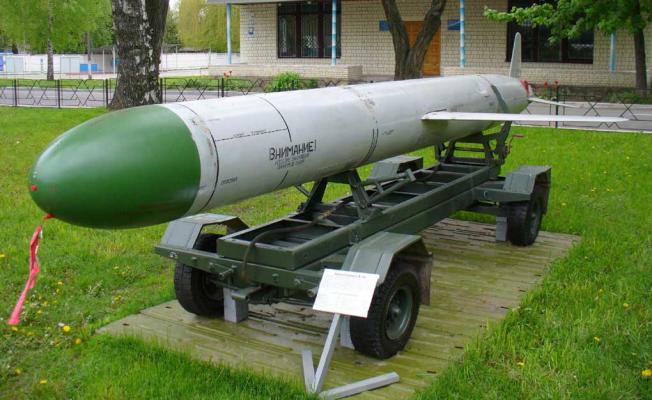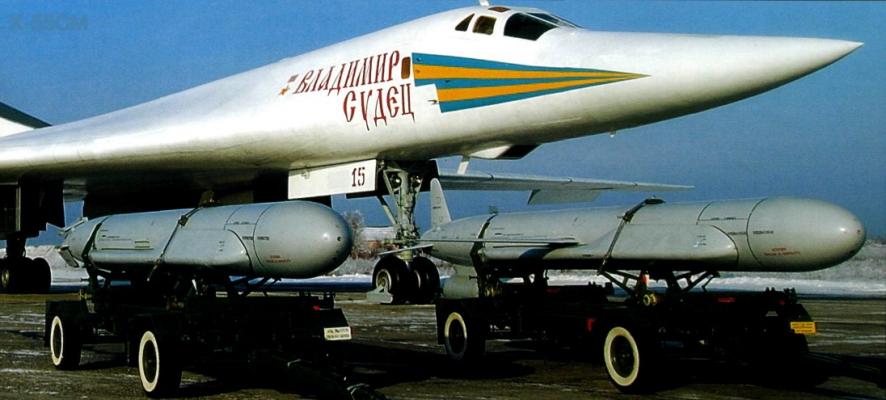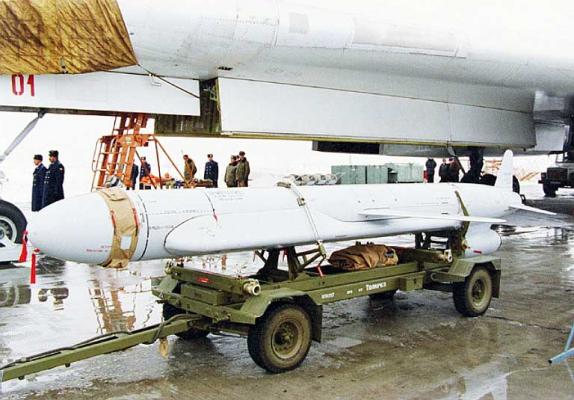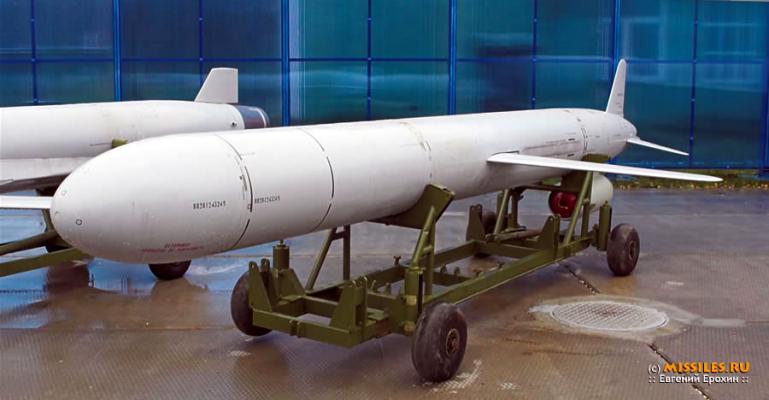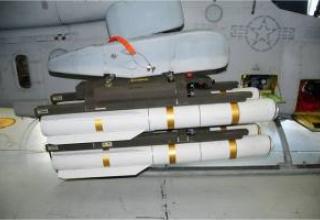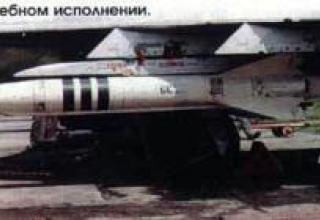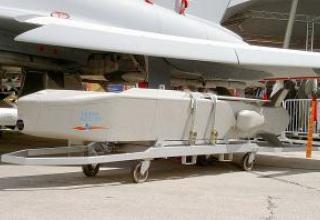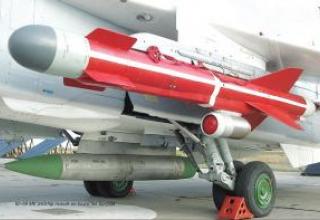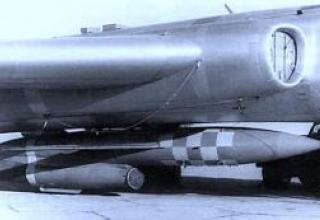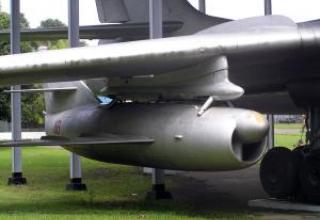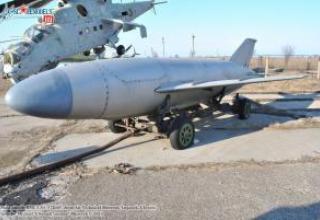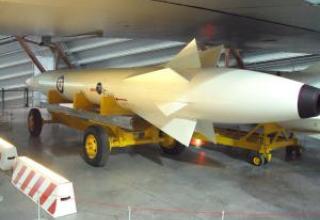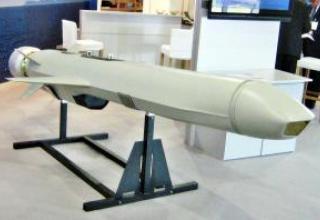X-55 is a subsonic small-size strategic cruise missile, flying with a low altitude terrain envelope, designed for use against important strategic objects of the enemy with pre-determined coordinates.
The missile was developed in the NGO "Rainbow" under the guidance of General Designer I.S.Seleznev in accordance with the Decree of the USSR CM dated December 8, 1976. The design of the new missile was accompanied by the solution of a mass of problems. Long range and low visibility, required high aerodynamic quality with a minimum weight and a large fuel reserve with an economical propulsion system. With the required number of missiles, their placement on the carrier dictated extremely compact forms and made it necessary to fold almost all protruding units - from the wing and plumage to the engine and the end of the fuselage. The result was an original aircraft with a folding wing and plumage, as well as a two-circuit turbojet engine, placed inside the fuselage and retractable down before detaching the rocket from the aircraft.
In 1983, for the establishment and development of production of X-55 a large group of employees of IBC "Rainbow" and Dubna Engineering Plant was awarded the Lenin and State Prizes.
In March 1978, the deployment of the X-55 production at the Kharkiv Aviation Industrial Association (KAPO) was started. The first serial rocket manufactured at KAPO was delivered to the customer on December 14, 1980.
Carriers of KR X-55 are strategic aircraft - Tu-95MS and Tu-160. Tu-95MS aircraft are distinguished by a modified cockpit, redesigned cargo compartment, installation of more powerful engines NK-12MP, modified electrical system, the new radar "Obzor-MS", equipment and communications. The crew of the Tu-95MS was reduced to seven people. The crew introduced a new post of navigator-operator, responsible for the preparation and launch of missiles.
Tests of the X-55 were very intense, which was facilitated by a thorough pre-testing of the control system on the model stands of NIIAS. During the first phase of the tests 12 launches were conducted, only one of which failed due to the failure of the power system generator and the loss of the rocket. In addition to the rockets themselves, the weapons control system was introduced from the launch vehicle, which carried out the launch mission and the exhibition of the rocket's gyroinertial platforms - the most precise link to the position and orientation in space for the start of autonomous flight.
The first launch of the serial X-55 was made on February 23, 1981. September 3, 1981 made a set-off launch with the first production car Tu-95MS ¹ 1. In March of the following year, it was joined by a second aircraft that arrived at the base of the Air Force Research Institute in Akhtubinsk to continue state trials.
The envisaged possibility of equipping the aircraft with underwings suspensions led to the production of two options: Tu-95MS-6, carrying six X-55 in gruzootseke on a multi-position catapult unit MKU-6-5 and Tu-95MS-16, additionally armed with ten more missiles - two on the internal underwings catapult units AKU-2 in the fuselage and three - on external units AKU-3, placed between the engines. Ejection of missiles, ejecting them at a sufficient distance from the aircraft and the disturbed air flow around it, was carried out pneumatic pusher, their return cleaning - hydraulics. After the launch, the ICU drum was rotated, feeding the next missile into the starting position.
Modernization of the Tu-95MS was set by government decree in June 1983. Equipment for the preparation and launch, standing on production aircraft, was replaced by a more modern, unified with the used Tu-160 and provided work with a large number of missiles. The stern cannon set with two AM-23 was replaced by a new UCU-9K-502-2 with twin GSh-23, were installed new means of communication and REB. Since 1986, the production of modernized aircraft began. Totally until 1991, the Air Force received 27 Tu-95MS-6 and 56 Tu-95MS-16 aircraft (the number is given according to the contract START-1), several more machines managed to deliver to the customer within the next year.
Test launches of X-55 were carried out virtually the entire range of carrier flight modes from altitudes of 200 m to 10 km. Starting the engine was quite reliable, the speed on the route, adjustable depending on weight loss during fuel production, was maintained in the range of 720 ... 830 km/h. At a given value of the CWO, in a number of launches it was possible to achieve remarkable results with hitting the target with a minimum deviation, which gave grounds to characterize the X-55 in the reporting documents as "super accurate". The planned launch range of 2500 km was also achieved during the tests.
December 31, 1983 the air-based missile system, which included a carrier aircraft Tu-95MS and cruise missiles Kh-55, was officially adopted. Teams of ICB "Rainbow" headed by I.S.Seleznev and KHAPO for the creation of X-55 were awarded Lenin and five State Prizes, 1500 employees of the plant were awarded government awards.
In 1986 production of X-55 was transferred to Kirov Machine-Building Plant. Production of X-55 units was also launched at Smolensk Aviation Plant. Developing a successful design, the Rainbow Design Bureau further developed a number of modifications of the base X-55 (product 120), including the X-55SM with extended range (adopted for service in 1987) and X-5555 with a non-nuclear warhead and an improved guidance system.
In the west, X-555 received the designation AS-15 "Kent".
Composition:
X-55 is made by the normal aerodynamic scheme with a straight wing of relatively large elongation. (see projections on the side, top, bottom) The plumage is entirely rotatable. In the transport position the wing and nacelle are retracted into the fuselage, and the plumage is folded (see the layout diagram).
Two-circuit single-shaft turbojet engine P-95-300 (see photo) with a circular combustion chamber, designed under the guidance of Chief Designer O.N.Favorsky, is located on a retractable subfuselage pylon. The low pressure compressor is a two-stage fan, the high pressure compressor is a seven-stage axial compressor. The oil system is autonomous. R95-300 develops a static take-off thrust of 300 ... 350 kgf, having a transverse size of 315 mm and a length of 850 mm. With its own weight of 95 kg, the R-95-300 has a weight return of 3.68 kgf/kg - at the TRD level of modern combat aircraft. The R-95-300 axial compressor, with a dual circuit level of 2, provided a compression level of 8.5. Specific air consumption is only 0.785 kg/kgf x h - much less than the similar parameter of TRD and DTRD of combat aircraft (for R-95Sh - 0.86 kg/kgf x h, for NK-22 - 0.96 kg/kgf x h). R-95-300 was created taking into account a fairly wide flight range inherent in cruise missiles, with the ability to maneuver in height and speed. The engine is launched by a pyrostarter placed in the tail coca of the rotor. In flight, when the nacelle is released, the fuselage tail coca is extended to reduce resistance (the coca is extended by a spring held in tension by a nichrome wire, which is burned by an electric impulse). To perform the flight program and regulation, P-95-300 is equipped with a modern automatic electronic-hydromechanical control system and a built-in 4 kW electric generator. In addition to the usual types of fuel (aviation kerosene T-1, TC-1 and others), a special synthetic combat fuel T-10 - decylin - was developed for R-95-300. T-10 is a high-calorie and toxic compound, and it was with this fuel that maximum missile performance was achieved. The peculiarity of T-10 is its high fluidity, which requires particularly careful sealing and sealing of the entire missile fuel system.
As the missile's range flight lasted several hours, conventional battery-powered power sources did not provide such a long service life for on-board systems. They are powered by the built-in small-size electric generator RDC-300.
The need to place a significant fuel reserve with limited size led to the organization of the entire fuselage of the X-55 in the form of a tank, inside which the wing, combat unit, fittings and a number of other units are placed in airtight openings. Flats of the wing are folded into the fuselage, placed one above the other. When releasing the planes are at different heights relative to the construction horizon of the product, fixing with different angles of installation, so the flight configuration of the X-55 becomes asymmetrical. Foldable and tail fins are made, all surfaces of which are wheeled, and the console hinged twice breaks. The keel was initially folded sideways, but then the consoles were unified, and on the keel there was another additional hinge. To reduce the overall length of the retractable tail coc was made and folded "harmonica". The nichrome wire that pulled it down was burned by an electric impulse and the coc was spread out by a spring.
The engine went down under the action of the pyroelectric pusher, after which the opening leaves of the hatch closed the opening, maintaining the aerodynamic purity of the product. The pyrotechnic pushers also opened the wing and plumage consoles, and these mechanisms worked at high pressures up to 350 atm., literally throwing the units out, where they were held by locks.
With regard to the assembly of the rocket, great effort required its manufacturability, which is necessary for mass production. The rocket, assembled from separate aggregates, had to have proper durability, rigidity and alignment of docking compartments, providing the required cleanliness and accuracy of bypasses - under the conditions the last one at X-55 was measured in fractions of millimeter. It was necessary to establish production of separate interchangeable compartments, assembled in parallel and going to the general assembly of the fuselage, which was reduced to welding the ring seams of "cigar". The fully welded design, which replaced the usual heavy-duty flange joint arrangements on bolts and studs, provided much greater weight perfection, but also required a specific assembly technique. The compartments were placed in the general assembly slipway, which set a clear correspondence of aggregates, were adjusted and docked on frames-belts, welded on the spot, and then all the "cigar" assembly was taken out of the slipway and boiled finally.
The peculiarity of X-55, caused by its extremely light and "delicate" construction, was the solution of suspension under the carrier. Usually rockets, including the heaviest ones, cost one bugel attached to a powerful bendshaft (so hung 12-ton X-20). For the openwork power scheme X-55 used the organization of the suspension with four spaced units, evenly distributing the forces on the structure. When assembling them had to be cut on a special machining center at the same time, as well as the attachment units of planes, achieving unambiguous compliance with the installation dimensions.
The X-55 fuselage power pack is formed by bends-frames, which carry the units, equipment and provide docking of the body compartments. Lightweight design, frames have made complex shapes, with very high thin-walled ribs and walls. Providing the given contours with numerous transitions on the thickness of edges and walls, the frames were made by precise stamping with the subsequent complex milling and boring on CNC machines and machining centers of the mechanical shop. The main and most difficult problem was welding of large structural parts. The fuselage was fully welded from AMG-6 alloy.
In addition to the proper strength, rigidity and accuracy of the contours, the tank compartment, which made up the entire fuselage, had to provide tightness, and the trouble added high fluidity of special fuel, capable of seepage everywhere. The task was complicated not only by the large number of welds, but also by their presence inside the compartments in hard-to-reach places. For example, the electric harnesses of the control valves were laid inside a flat tube welded into the structure that passed through the entire tank. Panels and assemblies made of AMG-6 were boiled by argon-arc welding on special welding machines, but some of the units in the compartments had to be boiled manually.
The finished product and all its seams were thoroughly checked for tightness. However, if external leaks were detected and eliminated quite simply, the internal tightness diagnostics was a problem. And such leaks were no less unpleasant - due to the fact that the engine, control units and BC were placed in the tank compartment, fuel leakage could disable the "filling" of the rocket. Possible defects of welding were checked by X-ray control, leaks and pores were detected by acetone, "clean" control for tightness was carried out by special liquid leak detectors based on helium, which has ultra-high fluidity and penetrating properties. At the slightest non-provrovar, "fistulas" and low thickness of the sheet, helium seeped even through the structure of the material and the crystal lattice of the metal.
An unpleasant side effect of welding was the warping of the structure due to residual internal stresses during heating. The fuselage elements were thermo-calibrated to remove deformations while observing the specified contours. To avoid a "leash", the welded components were placed in thick-walled steel sleeves with electric heating, where they were released.
Measures to reduce radar and thermal signature have been implemented in the missile design. Due to the small middlet and clean bypasses, the missile has a minimum EPR, which makes it difficult to detect by air defense. The surface of the hull has no contrast slits and sharp edges, the engine is covered by the fuselage, widely used structural and radio absorbent materials. The lining of the fuselage nose, wing and plumage is made of special radio absorbent materials based on silicon composite.
The missile guidance system is one of the essential differences between this cruise missile and previous aircraft weapons systems. The missile uses an inertial guidance system with location correction on the terrain. A digital terrain map is entered into the onboard computer before launch. The control system provides long autonomous flight of X-55 regardless of the length, weather conditions, etc. Usual autopilot on Kh-55 was replaced by electronic onboard control system BSU-55, which worked out a given flight program with the stabilization of the missile on three axes, holding the high-speed and high-altitude mode and the ability to perform given maneuvers to evade interception. The main mode was the route passage at extremely low altitudes (50-100m) with the relief envelope, at a speed of the order of M=0.5-0.7, corresponding to the most economical mode.
X-55 is equipped with a newly developed compact thermonuclear BC with a 200Kt charge. At a given accuracy (CWO no more than 100m), the charge power provided the defeat of the main targets - strategic centers of state and military administration, military industrial facilities, nuclear weapons bases, missile launchers, including protected objects and shelters.
Carriers of the missile are long-range bombers TU-95MS and Tu-160. Each Tu-95MS-6 bomber can carry up to six missiles, located on the drum launcher MKU-6-5 catapult type in the cargo compartment of the aircraft (see photo). Variant Tu-95MS-16 has sixteen X-55: six on MKU-6-5, two on the inner wings of the ejection unit AKU-2 in the fuselage and three - on external units AKU-3, placed between engines. In two gruzootseke supersonic Tu-160 can accommodate 12 long-range cruise missiles X-55SM (with additional tanks) or 24 conventional cruise missiles X-55.
Modifications to the rocket:
X-55OC (product 121) differs guidance system with an optical correlator on the reference image of the area.
Modification of X-55SM (product 125) is designed to hit targets at a distance of up to 3500 km. The guidance system remained the same, but a significant increase in range required almost one and a half times the fuel reserve. In order not to change the used design on the sides of the fuselage equipped with conformal tanks for 260 kg of fuel, almost did not affect the aerodynamics and balancing of the rocket. This design allowed to save the size and possibility of placing six missiles on the ICU inside the fuselage. However, the weight increased to 1465 kg forced to limit the number of missiles on the underwings TU-95MS (can hang eight X-55SM instead of ten X-55).
The non-nuclear version of the X-55 received the designation X-555 (see photo). The new missile is equipped with an inertial-Doppler guidance system that combines topography correction with optoelectronic correlator and satellite navigation. As a result, the CWO was about 20 m. The new missile is equipped with an inertial Doppler guidance system that combines terrain correction with an optoelectronic correlator and satellite navigation. The X-555 can be equipped with several types of BC: blast, penetrating - to hit protected targets or cassette with shrapnel, blast or cumulative elements to hit the area and long targets. Due to the increase in the mass of BC, the fuel reserve and, accordingly, the flight range was reduced to 2000 km. Eventually, the more massive BC and new control equipment increased the starting mass of X-555 to 1280 kg. The X-555 is equipped with conformal suspended tanks for 220 kg of fuel.
The X-65 is a tactical anti-ship modification of the X-555 with a conventional warhead.
Characteristics:
| Length, m | |
| - Х-55SM | 6.040 |
| - Х-55 | 5.880 |
| Hull diameter, m | |
| - Х-55SM | 0.77 |
| - Х-55 | 0.514 |
| Wingspan, m | 3.10 |
| Start weight,kg | |
| - Х-55SM | 1465 |
| - Х-55 | 1185 |
| - Х-555 | 1280 |
| Battle unit power, kt | 200 |
| Weight of combat unit, kg | 410 |
| Flight Range, km | |
| - Х-55SM | 3500 |
| - Х-55 | 2500 |
| Flight Speed, m/s | 260 |
| Flight height on the march section of the trajectory, m | 40-110 |
| Launch height, m | 20-12000 |
| Speed range of the carrier aircraft, km/h. | 540-1050 |
Testing:
The first flight of the prototype carrier aircraft Tu-95M-55 (BM-021) took place on July 31, 1978. A total of 107 flights and launches of ten X-55s were made on this machine by the beginning of 1982. The plane was lost in the crash January 28, 1982 on takeoff from Zhukovsky because of pilot error.
The tests of the X-55 were very intensive, which was facilitated by a thorough pre-testing of the control system on the model stands of NIIAS. During the first stage of the tests 12 launches were conducted, only one of which failed due to the power system generator failure. In addition to the missile itself, the weapon control system was brought to the surface of the launch vehicle, which was used to launch the mission and exhibit the missile's gyroinertial platforms.
The first launch of the serial X-55 was made February 23, 1981. September 3, 1981 the first set-off launch was made with the first production car Tu-95MS. Tests of the complex were conducted on the route measuring complex of the 929th LIC. Test launches of X-55 were carried out virtually the entire range of flight modes of the carrier from altitudes of 200m to 10km. The engine was launched reliably, the speed on the route, adjustable depending on weight loss during fuel production, was maintained in the range of 720-830 km/h. With a given value of CVO not more than 100m in a number of starts a deviation of only 20-30m was achieved.
The first to master the new complex started in Semipalatinsk 1223rd TBAP, which on December 17, 1982. arrived two new Tu-95MS. Since 1984, retraining on the Tu-95MS began adjacent 1226th TBAP of the same Semipalatinsk 79th TBAD. At the same time there was equipping of Tu-95MS regiments YES in the European part of the USSR - 1006 TBAP in Uzin near Kiev and 182nd TBAP in Mozdok, which was part of the 106th TBAD. In the division were concentrated more advanced Tu-95MS-16. The first Tu-160 arrived in April 1987 in the 184th TBAP, which was located in Priluki in Ukraine. Three months later, August 1, 1987 the crew of regiment commander V.Grebennikov first performed the launch of X-55.
After the collapse of the USSR, most of the X-55 missiles and their carrier aircraft remained outside Russia, in particular, in Kazakhstan and Ukraine, where there were, respectively, 40 Tu-95MS in Semipalatinsk, 25 in Uzin and 21 Tu-160 in Priluki. Together with the aircraft in the Ukrainian bases remained 1068 missiles X-55. With Kazakhstan, we managed to agree quickly enough, exchanging heavy bombers for proposed Russian fighters and attack aircraft. By February 19, 1994 all TU-95MS were ferried to the Far Eastern airfields, where they were equipped with the 182nd and 79th TBAP. The negotiations with Ukraine lasted a long time. Eventually, three TU-95MS and eight TU-160, which flew to Engels in February 2000, were transferred by the Ukrainian side on account of debts for gas. At the end of 1999, 575 air-based cruise missiles X-55 and X-55SM were also delivered from Ukraine to Russia.
In the Russian Air Force, all the forces of the YES were combined into the 37th Air Force. In its composition by July 2001, there were 63 Tu-95MS aircraft with 504 missiles Kh-55, as well as 15 Tu-160. The first practical launch of X-55SM from the Tu-160 was made by the crew of Colonel A. Zhikharev October 22, 1992. In June 1994, four Tu-95MS and Tu-160 took part in the exercises of the Russian Strategic Nuclear Forces, having worked out tactical launches over the North Sea and then executed the actual firing of X-55SM at the range. In September 1998, a group of four Tu-95MS 184th TBAP were made launches of X-55 in the area of the Northern Fleet training ground Chizha, where the missiles were 1500 km to the target.
During the exercise "West 99" in June 1999, a pair of Tu-95MS from Engels performed a 15-hour flight, reaching Iceland, and on the way back made a launch of X-55 on a training target in the Caspian Sea. In October 2002, the crew of the Tu-160 Colonel Yu Deineko in a night flight passed the route over the circumpolar areas, performing a practical launch of X-55SM. May 14, 2003 the four Tu-95MS and six Tu-160 participated in exercises covering the Persian Gulf and the Indian Ocean. Launches of the X-55 from the Tu-95MS were held during the strategic command training of land, sea and air SNF in February 2004.
Sources:
- В.Марковский, К.Перов "Крылья судного дня"- "Мир оружия", N 04(07) апрель 2005 - С. 48-55.
- Все цвета Радуги / «Вестник воздушного флота» /
- Мороз С.Г., Попсуевич С. Управляемые ракеты дальней и морской авиации СССР. - М.: "Майор", "Пилот", 2001. - С. 64-68.
- Х-55
- http://paralay.com/tu160/5505.jpg
- Авиационные двигатели/АМНТК "Союз"/
